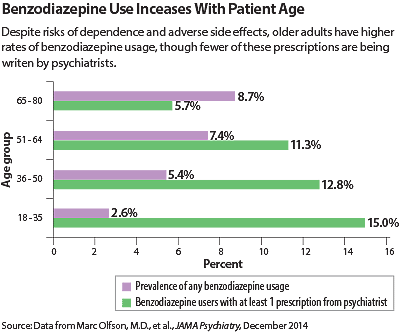Benzodiazepines such as Valium have been around for decades, and while effective for treating anxiety or insomnia, they are no longer recommended front-line therapies for these conditions—as there are safer, effective options.
The reservations stem from the potential side effects of benzodiazepines, including impaired thinking, movement, and balance as well as a risk of dependence if used too long. These risks are especially pronounced in older individuals, which makes the findings of a new surveillance study particularly troubling.
As published in JAMA Psychiatry, the study found that in 2008 a little over 5 percent of adults aged 18 to 80 used benzodiazepines, but the prevalence scaled with age. While 2.6 percent of people aged 18 to 35 used these drugs, 8.7 percent of people aged 65 to 80 did so.
Of those elderly users, nearly one-third had long-term prescriptions (120 days or more of supply during the year), compared with around 14 percent of people aged 18 to 35 receiving long-term prescriptions.
“With a study like this, we cannot get down to the level of individual patients or providers and say that someone was getting overprescribed or receiving the wrong drug,” said the National Institute of Mental Health’s Michael Schoenbaum, Ph.D., one of the study authors. “But based on the expert consensus, a national pattern like we observed is hard to reconcile.”
Schoenbaum, who conducted the study with Mark Olfson, M.D., M.P.H., of Columbia University and Marissa King, Ph.D., of Yale University, suggested that several factors might contribute to increased benzodiazepine prescriptions among the elderly. For example, older people might be more familiar with this established class of drugs, which was extremely popular back in the 1970s and 1980s. A lack of access to behavioral therapy—which is recommended first for insomnia—among the elderly may also play a role.
However, those who prescribe benzodiazepines also merit some attention, the researchers suggested. For all groups and ages, a majority of prescriptions were filled by nonpsychiatrists, and again this scaled according to age, as the lowest rate of psychiatrist prescriptions—5.7 percent—occurred in adults aged 65 to 80.
The benzodiazepine prescribing patterns of psychiatrists were more appropriate, as psychiatrists were less likely to prescribe them long term. They also prescribed to men and women at equal levels, whereas benzodiazepine use was twice as prevalent in women as men among all age groups.
In a commentary accompanying the study, Nicholas Moore, M.D., and colleagues at the University of Bordeaux in France suggested that benzodiazepine prescribing should be restricted to psychiatrists, while the drugs themselves might need to be classified as a controlled substance, as is the case with opiates.
“Other medications with potentially more benefits and less absolute risks have been taken off the market. If benzodiazepines were new antidiabetic drugs with even one-hundredth of their burden of harms, they would be immediately removed,” the commentary authors said.
While Schoenbaum does not believe such serious measures need to be implemented just yet, “I do think physicians need to restart a conversation about the safety of benzodiazepines, particularly in the elderly,” he said. He noted that at the time when the study data were collected (2008), benzodiazepines were excluded from Medicare Part D as an anxiety medication, but in 2013 they were reinstated as part of the Affordable Care Act, an action that could increase access.
“And if I can make a pitch for a second, this shows why descriptive epidemiology studies like this one are valuable,” Schoenbaum added. “They enable us to have discussions about clinical care that are informed by data. Who knows what other trends are going on that we don’t know about because we don’t have detailed surveillance data.”
This analysis was carried out using the LifeLink LRx Longitudinal Prescription database, which contains detailed—though anonymous—prescription data from over 30,000 retailers; this information reflected over 60 percent of all retail prescriptions filled in 2008, providing a representative sample.
The study was supported by the National Institutes of Health, the Agency for Healthcare Research and Quality, and the New York State Psychiatric Institute. ■
“Benzodiazepine Use in the United States” can be accessed
here.

